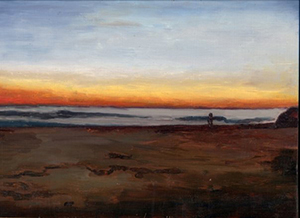The Company of Men
June 2 - July 9, 2011
Opening Reception: Friday, June 10, 6-9pm

The Company of Men, an exhibition by George Towne, is a subjective perception of masculine menʼs desirability and beauty. The artistʼs 2007 painting, Fire Island- Sunset (Study), is similar to the Romantic painting, The Monk by the Sea, by Caspar David Friedrich. Each painting represents the emphasis of aesthetic experience, whether it is the playground of Fire Island for gay men as depicted in Fire Island-Sunset (Study) or an allegory of nature versus human in The Monk by the Sea. The paintings are a catalyst for each artistʼs maturity and therefore create an existential epiphany.
Through the reflection of his sexual identity, Towne was able to develop a true passion for male portraitures. The oil paintings synthesize the polemics of a gay male gaze. Towneʼs juxtaposition of men in blunt and provocative poses with that of nudity and tenderness is aesthetically visceral. The paintings are an outlet for Towne to release a liquid flow out of a tube onto a canvas, therefore implicating his desire for these masculine men. Through an abjection of masculinity, Towne displays the social construct of how gay men are often perceived to have a masculine corporeal selfmisrelation. The release of the paint and the rendered context empower gay menʼs masculinity and deconstructs perceptions of identity and alterity.

Like Paul Cadmus before him, Towne transcends social aggregates of male beauty and desire. Subjects are positioned in confrontational and stylized mannerisms so as to legitimize menʼs sexuality and disembody male anxieties about being bare to public scrutiny. Also, Towneʼs male portraitures resemble that of Thomas Eakinsʼ male nudes created during the late nineteenth century.
Eakinsʼ depictions of male nudes went beyond that of his predecessors and created a veristic portrayal of the male body. Rather than conform to the idea of hegemonic masculinity often associated with the advent of modernity, Eakins illustrates male beauty as exposed, yet natural. Although classically trained, Eakins stripped men of their customary sophistication and depicted them in a native state.
The oil portraitures Towne creates seem to recontextualize the disparities that Eakins faced during a time when homosexuality was becoming linguistically characterized. Towneʼs paintings and drawings reflect the progression society has made in distinguishing what it is to be a contemporary gay male. The men Towne incorporates are of various ethnicities and captures the beauty and desire of each one regardless of their heritage. Each subject is placed in a setting that compliments his figurative verisimilitude.
Similar to Eakins, Towne places the men in confined and stark rooms. The confined setting establishes an intimate connection for the viewer and the viewed. The subjects are captured in states of reflection, often staring into the distance so as to accentuate the definition of their physiognomy. The esoteric reflection highlights how the GLBT community is often marginalized into subcategories of a larger culture. That is, declaring a person, a gay white male, gay black male, gay Asian male, etc. Towneʼs inclusion of all gay men allows for an amalgamation of the community as a whole and debunks any physical characteristics that may “separate” us.
Curatorial Essay by Eric Fuge
